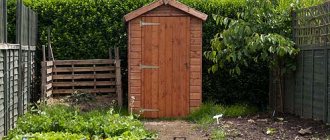From the history of the creation of flower watches
Many major cities have flower clocks. As a rule, they are located somewhere near the central square. Flowers in them play an exclusively decorative role. The basis of such structures is formed by a special mechanism that moves the hands. Essentially, it is a mechanical device that differs from what every home has, only in size.
The inside of this watch contains a complex control system. Essentially, these are the same mechanical watches as the ones we wear on our wrists

The famous Swedish naturalist and doctor Carl Linnaeus created a flower clock, which is fundamentally different from the mechanical ones invented much later.
Real flower clocks first appeared in Ancient Rome long before the invention of their mechanical version. Scientists already at that time noticed the interdependence of time of day and plant behavior. The natural biorhythms of flowers made it possible to fairly accurately divide the day into time periods. From early spring to late autumn, people could be guided by the knowledge they received.
As an invention, the flower clock first appeared in Sweden. The idea was finalized by the brilliant biologist Carl Linnaeus, who devoted a lot of time to botany. The scientist’s thought was embodied in a design that had the shape of a circle divided into sectors.
Each sector was occupied by a plant, the inflorescences of which opened at a specific time of day. Flowering moved from sector to sector just as one hour followed another.
When did they appear?
The first natural clocks appeared in Ancient Rome. They were a rectangular flower bed in which plants were planted, often completely incompatible in color or shape. But the flowers closed and bloomed at certain times of the day.
In the mid-18th century, the idea of the ancient Romans was refined by the Swedish botanist Carl Linnaeus. After many years of observations, the scientist arranged the plantings in a circle in the form of sectors. Plants planted in each subsequent sector bloomed an hour after the previous one. Taking into account the fact that the flowers in the first sector bloomed at about 4 a.m., this design made it possible to determine the time of day with an accuracy of an hour.
Carl Linnaeus's garden became very popular. People of all ages were mesmerized by the unusual spectacle of flowers opening at exactly the right time. Since then, such flower beds began to be planted on city streets and garden plots as an interesting decoration.

Floral clock with dial
Features of plant biorhythms
Early in the morning a cheerful dandelion opens towards the sun. Lunch time has ended and the water lilies, having closed their buds, plunge under the water. In the twilight of the garden, the nocturnal violet awakens. Clear daily biorhythms are inherent in many plants. They bloom and stop blooming depending on the light and, accordingly, the time of day. Each flower has its own routine.
As it turns out, the secret of colors lies in the pigments that each of them contains. The two phytochrome pigments transform into one another depending on the time of day. When daylight is absorbed, one pigment turns into another. With the onset of darkness, a reverse transformation occurs. This is how the flower “understands” what time of day it actually is.

Each plant has its own routine. Submitting to its internal regime, its buds open and close
Interestingly, changing the conditions of detention has virtually no effect on the internal biorhythms of the plant. Even in a dark basement, the bud will open when it would need to do so in the light. And after a certain time period has passed, it will close. Although, if exposed to artificial lighting for a long period of time, biorhythms may be disrupted. But this will not happen right away.
Making your own flower clock
Making a flower clock with your own hands is not as easy as it might seem. Although this activity is interesting and extremely educational. We highly recommend involving children in this work. Along the way they will receive an object lesson in solar astronomy and entertaining botany.
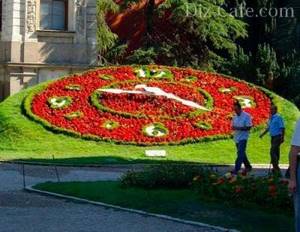
Some flower beds only imitate a clock, others actually show the time. It’s just that the shape of the watch looks very impressive and is especially popular
Do not forget that the biorhythms of plants of the same species depend on weather conditions, the geographic latitude of the area where your site is located, as well as on the level of natural light. It is possible that the preliminary information you received will require adjustments.
The flower clock needs clear, sunny weather to work. You shouldn’t count on them to show you the exact time even in the rain, this won’t happen.
We need sun and flowers
To create a real floral sundial, you will need several types of flowers. The general operating principle is that the flowers should open and close at certain times, indicating what time it is.
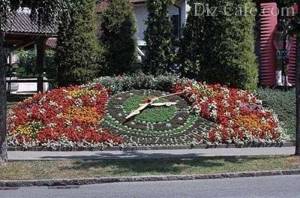
Clocks surrounded by flowers are very popular not only in Russian cities, but also abroad. They invariably become the center of everyone's attention and a spectacular backdrop for photographs of tourists.
We decide on the main parameters:
Recent Entries
5 working ways to use tar in the garden 7 indoor plants that help you get married even in adulthood Indoor plants that can bloom in trouble
- We choose a place for a future flower bed in our garden plot. We need an open space that is not blocked from sunlight. Make sure that no shadows of any buildings, trees or shrubs fall on the site.
- If you want the future structure to perform not only a decorative function, but also to be used for its intended purpose, build it in a visible place. For example, at the crossroads of several garden paths.
- The round shape of the dial is traditional and comfortable. After preparing the soil for planting seedlings, it is necessary to divide our round area into 12 sectors. Each of them will symbolize one hour.
- The “dial” circle should be separated from the rest of the lawn. You can make it stand out by covering it with small pebbles of a contrasting color or filling it with gravel.
- Remember that in the rain the buds may not open at all. Bad weather knocks plants out of the natural biorhythms that are inherent to them, so do not rely on the accuracy of the “move”.
It is very important to choose the right seedlings for flower clocks. To do this, you need not only theoretically know the opening and closing times of their buds, but also how they behave in your specific area. Taking into account the time period of flowering, you will have to place the seedlings in the sectors allocated for them.
To help you choose suitable flowers, we provide below information on plants whose daily biorhythms are most pronounced. Observe the objects chosen for planting and create your own table of their biorhythms. Then there will be no mistakes with the choice.

This table is a real find for any gardener. With its help you can create not only flower clocks, but also very harmonious flower beds
If you're afraid you won't be able to handle such a large-scale job, you can start small. For example, make a simplified design that will show the time when it is time to have breakfast, lunch and dinner.
Violets, coltsfoot and calendula, which open their flowers between 7 and 10 am, will remind you that it is time to have breakfast. When, between 1 and 3 p.m., the charming poppies and bells close their bright petals, it’s time for lunch. In the period from 20 to 21 night flowers open - noctule and fragrant tobacco. It's late dinner time. Choose plants whose biorhythms match your own. Let them decorate the flowerbed and signal when it's time for a snack.
Dial with shadow hand
If the previous designs seemed too complicated and not very effective to you, we offer you an option that is easier to implement technically. By the way, the appearance of the proposed flowerbed will be no worse, and perhaps even better than the previous one. We advise you to make a sundial in which flowers will play a decorative function.
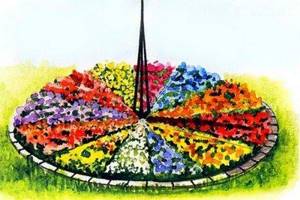
In this case, the flower clock is supplemented with a gnomon, which allows it to show time more accurately: the biorhythms of flowers are duplicated by the shadow cast by the gnomon
Time will tell the shadow cast by the gnomon - a high column, which can be used as reinforcement or a wooden stand. We mark a circle that will be well lit by the sun. We install the gnomon in its center so that it has a slight slope to the north. To accurately determine the direction, you should use a compass, and it is better to carry out all work at 12 noon. The shadow of the gnomon at this moment should point to the top point of our dial.
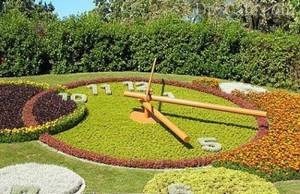
In the central part of the clock there is a gnomon, which is installed at an angle towards the north. Its shadow shows the exact time
At the intersection of the shadow with the circle, mark 12. Further marks will need to be made every hour. The most important part of the work will be completed with the final mark. From the marks to the center we designate sectors that can be decorated to your liking. Sector boundaries are usually marked with gravel or flower borders. The sectors are filled with low-growing plants.
The advantage of this option is that you can use a variety of decorative options and flowers, without reference to the timing of their flowering. You can simply make a neat round lawn, equipped with clearly visible numbers printed on moisture-resistant plywood. For the background of the general circle or sectors, you can use any ground cover. For borders - juveniles, sedums and similar species.
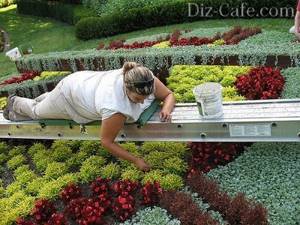
The larger the watch, the more difficult the work of creating it. The giant city clock is made by a whole team of several people. Flowers for them are grown in advance
Advantages and disadvantages of watches
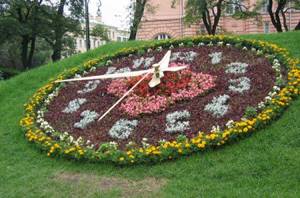
Flower clock in the country
Flower clocks are created not to know the exact time of day, but to create an unusual garden decor with a “zest” in the form of a dial in a summer cottage. That is why it is necessary to select beautiful plants and create a harmonious flower garden from climbing, bulbous and other types of flowers.
The advantage of a flower clock lies in the beauty of this garden idea, as well as in its low functionality (an experienced gardener can easily determine the time of day if he forgot to take his phone or wristwatch).
Flower watches have many more disadvantages. Among the main ones are:
- Flowers require a lot of care. A flower watch requires a lot of attention, because... if one of the sections of the dial dries out, the entire composition will lose its attractiveness.
- To create a flower clock, you will need a lot of free space in the open sun (any shadow can affect the period of opening or closing of the flower, which will increase the error in showing the time).
- In cloudy and rainy weather, the flower clock will not function.
- It is extremely difficult to choose the right flowers that can differ in flowering time and at the same time visually combine with each other.
- Making a flower clock can be time consuming and expensive.
To summarize, it should be noted that flower clocks are suitable only for those summer residents who prioritize garden decor and have enough money and free time.











